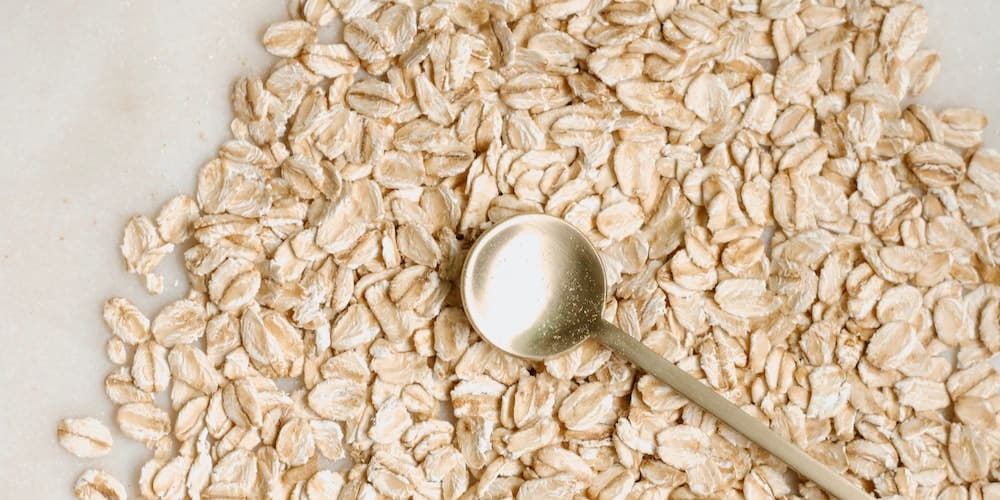BENEFITS OF OATS
✓ Reduces cholesterol
✓ Improves intestinal transit
✓ Improves diabetes
✓ Aids in weight loss
✓ Potentially anti-cancer
What is oats?
Oats are a plant belonging to the grass family. The Avena genus includes different varieties, the most well-known of which is Avena sativa or “cultivated oats“.
This plant is one of the oldest cereals domesticated by humans. The first traces of its introduction date back to between 4500 and 400 BC, in the northern regions of Europe (Anglo-Saxon and Scandinavian countries). It was then cultivated as a cereal but also as a forage plant for animal feed.
It can grow up to 1 meter in height. Like barley or rye, it produces spikelets that group several flowers. Each flower contains grains that are harvested once matured (in July-August).
Unfortunately, over the centuries, its cultivation has continuously declined. In France, cultivated areas have decreased from 800,000 hectares in the 1970s to 100,000 hectares in 2010. Other cereals with higher yields like wheat or maize have gradually replaced it.

But today, oats are making a comeback, supported by their nutritional advantages and health benefits. Indeed, they are one of the most complete and nutritious cereals.
Rich in fiber, oats help reduce cholesterol levels and improve diabetes. They are also known for their beneficial effect on intestinal transit and weight loss. Finally, they may have promising anti-cancer effects.
Cultivated oats are mainly intended for human and animal consumption. But today, they have found another use as green manure. Like buckwheat and lupin, they enrich the soil with nitrogen and improve its structure.
Furthermore, oats halt the progression of weeds, thereby limiting the use of chemical herbicides.
Nutritional Composition
- 18 amino acids
- Vitamins: B1, B3, B5, B6, E
- Minerals and trace elements: magnesium, manganese, phosphorus, potassium, copper, iron, selenium, zinc, sodium
- Carbohydrates
- Fiber
- Proteins
- Fatty acids: omega 3-6-9
- Antioxidant active compounds: avenanthramides
- Organic acids: ferulic acid, phytic acid

The benefits of oats
🍳 Reduces cholesterol
Oats contain a large amount of fiber: around 10 g per 100 g. These are mainly soluble fibers, which give them beneficial effects on cholesterol levels. Indeed, soluble fibers can capture excess cholesterol and facilitate its elimination via stools.
Specifically, they contain beta-glucan, a particularly effective form of soluble fiber for reducing LDL or “bad cholesterol” levels.
This study from the University of Manitoba (Canada), conducted on humans, shows the hypoglycemic effect of oat beta-glucan.
♻️ Improves intestinal transit
Consuming oats can have beneficial effects on intestinal transit. Thus, they facilitate digestion, relieve constipation, and boost sluggish transit. They also help maintain regular bowel movements and promote their progression through the intestine. Lastly, they play a role in preventing colorectal cancer and relieve inflammatory bowel diseases and celiac disease.
This review from the University of Aberdeen (UK) explored the benefits of oats on bowel diseases.
🍭 Improves diabetes
The soluble fibers in oats also help improve type 2 diabetes (or sugar diabetes). They aid in normalizing glucose levels in the blood and prevent blood sugar spikes after meals.
For this, they slow down the absorption of carbohydrates (sugar) in the intestines. At the same time, its fibers, including beta-glucan, improve insulin sensitivity.
This study from Sichuan University (China), conducted on diabetic patients, shows the beneficial effects of oats on blood sugar control.
🏃🏻♂️ Helps with weight loss
Thanks to its high fiber content, oats can be a valuable aid for weight loss. Indeed, it acts as a natural appetite suppressant by promoting the feeling of fullness.
The beta-glucans it contains notably cause the release of cholecystokinin, a hormone that slows gastric emptying and induces satiety. Furthermore, its benefits on intestinal transit help maintain a flat stomach.
This review from Louisiana State University (USA) shows the positive effects of oats on the feeling of fullness.
🔬 Potentially anti-cancer
Some studies have shown that oats exert anti-cancer effects, particularly against colon cancer. Indeed, it contains antioxidant polyphenols called avenanthramides. These have an anti-inflammatory and anti-proliferative action on cancer cell lines.
This review from Tufts University (USA) explains the anti-cancer effects of oat avenanthramides.
How to consume oats?
Oat flakes
Oat flakes are produced from whole grains or grains stripped of their husk. They are then cleaned, steamed, and dried. Finally, they are pressed and flattened using a flaker. This careful process allows the flakes to retain all their nutrients.
The flakes have a rather neutral taste. Ideally, they are added to muesli, porridge, pancakes, cereal bars, pastries… You can also prepare them in savory versions in salads, risotto, vegetarian patties…
Oat bran
Oat flakes should not be confused with oat bran, which is composed solely of the grain’s husk and not the whole grain. It has the advantage of being less caloric than the flakes, being richer in fiber, and thus further promoting the feeling of fullness.
The bran can be mixed with hot or cold milk, prepared in porridge, mixed with muesli, yogurt… It can also be added to your baking preparations or smoothies.
Oat milk
To obtain oat milk, the grains are soaked in water, blended, and then filtered. The milk stands out for its mild taste and creamy texture. It can be drunk as is or added to cereals, pancake recipes, purees…
Oats and gluten
Oats are often thought to be ideal for people who are lactose intolerant or have celiac disease. However, be sure to choose products certified by AFDIAG (French Association of Gluten Intolerants), as even though oats do not contain the same gluten as wheat, they contain avenin, which may have similar effects.

Consume sustainably: prefer organic and local oats
✓ Russia, Canada, Poland, Australia, and Finland concentrate the majority of production worldwide. France, for its part, produces about 540,000 tons of oats per year. The cultivated areas are spread between the Centre region, Brittany, and Burgundy. Most of this production is first intended for animal feed and then for the food industry.
✓ If you can, choose French-origin oats grown in organic agriculture. It is also possible to find them coming from fair trade.
Dosage
It is recommended to consume 40 g of flakes per day. You can drink up to 3 cups (750 ml) of milk per day.
It is advised not to exceed 3 tablespoons of bran per day.
Contraindications and side effects
The consumption of oats presents certain contraindications :
- People sensitive to avenin or allergic to wheat should avoid consuming it
- Due to its hypoglycemic action, diabetic individuals should seek medical advice ;
- People with celiac disease should consume it in moderation.
Excessive consumption presents certain side effects :
- Digestive disorders
- Bloating
- Flatulence
- Allergic reaction
If you experience side effects, stop your consumption and consult a doctor.
Article by Julia Perez
Sources and scientific studies
Rgia A Othman, Mohammed H Moghadasian, Peter Jh Jones, 2011. Cholesterol-lowering effects of oat β-glucan.
Frank Thies, Lindsey F Masson, Paolo Boffetta, Penny Kris-Etherton, 2014. Oats and bowel disease: a systematic literature review.
Qingtao Hou, Yun Li, Ling Li, Gaiping Cheng, Xin Sun, Sheyu Li, and Haoming Tian, 2015. The Metabolic Effects of Oats Intake in Patients with Type 2 Diabetes: A Systematic Review and Meta-Analysis.
Candida J Rebello, Carol E O’Neil, Frank L Greenway, 2016. Dietary fiber and satiety: the effects of oats on satiety.
Mohsen Meydani, 2009. Potential health benefits of avenanthramides of oats.



